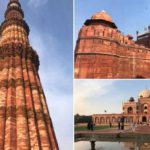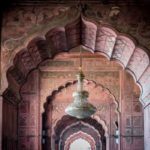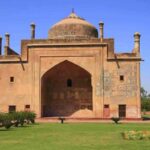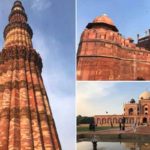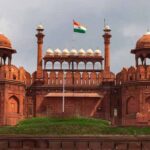Humayun Tomb Delhi, India, stands as a majestic testament to Mughal architecture and history. Constructed in the mid-16th century, it was commissioned by Hamida Banu Begum, Humayun’s widow, and designed by Persian architects. This UNESCO World Heritage Site is renowned for its grandeur and symmetry, blending Persian and Indian architectural styles.
The tomb’s impressive red sandstone structure, adorned with intricate marble inlay work, stands amid a vast charbagh (four-part) garden, typical of Mughal garden design. The central octagonal tomb chamber, crowned by a double dome, is a masterpiece of architectural finesse and symmetry.
Humayun’s Tomb holds historical significance as the burial place of the Mughal Emperor Humayun, whose reign marked the beginning of the illustrious Mughal era in India. It served as a precursor to the architectural splendor of later Mughal monuments like the Taj Mahal.
Today, the tomb complex is not only a revered historical site but also a popular tourist destination and a serene oasis amidst the bustling city of Delhi, inviting visitors to marvel at its architectural magnificence and reflect on India’s rich cultural heritage.

History of Humayun Tomb Delhi
Humayun’s Tomb in Delhi is a monument steeped in history, representing a pivotal era in India’s architectural and cultural development.
Commissioned by Hamida Banu Begum, the widow of Mughal Emperor Humayun, in 1565, the tomb was designed by Persian architects Mirak Mirza Ghiyas and his son, Sayyid Muhammad. Its construction marked the transition from the predominantly Islamic architecture of the Delhi Sultanate to the opulent Mughal style that reached its zenith under Emperor Shah Jahan.
The tomb’s construction took around nine years to complete and is believed to have cost about 1.5 million rupees, an enormous sum at the time. Its design reflects a fusion of Persian and Indian architectural elements, setting the stage for the architectural marvels of the later Mughal period.
After its completion, Humayun’s Tomb served as the final resting place for several subsequent Mughal rulers, including Emperor Jahangir and his wife Empress Bega Begum. However, over time, the monument fell into disrepair.
During the British colonial era, efforts were made to restore and preserve Humayun’s Tomb, culminating in extensive restoration work in the 20th century. In 1993, it was declared a UNESCO World Heritage Site, recognizing its cultural significance and architectural splendor.
Today, Humayun Tomb Delhi stands as a symbol of India’s rich heritage, attracting visitors from around the world who come to admire its grandeur, learn about its history, and appreciate the intricate craftsmanship that went into its creation.

Humayun’s Tomb Architecture
Humayun’s Tomb in Delhi is an architectural marvel that exemplifies the fusion of Persian and Indian architectural styles. Commissioned by Hamida Banu Begum, the widow of Mughal Emperor Humayun, the tomb was built between 1565 and 1572 AD. Designed by Persian architect Mirak Mirza Ghiyas, it served as a precursor to the grandeur of later Mughal monuments, including the Taj Mahal.
The tomb is characterized by its symmetrical design and meticulous craftsmanship. It is constructed primarily of red sandstone, with white marble accents and intricate inlay work. The central feature is the octagonal tomb chamber, topped by a double dome that reaches a height of 42.5 meters, making it one of the tallest structures of its time. The dome is adorned with geometric patterns and calligraphic inscriptions from the Quran.
Surrounded by a charbagh, or quadrilateral garden, the tomb complex is divided into four main parts, with water channels and pathways leading to the central structure. The garden itself is a Persian-inspired concept, representing the paradise garden, with meticulously planned symmetry and lush greenery.
The architectural significance of Humayun Tomb Delhi lies not only in its aesthetic beauty but also in its innovative structural elements, such as the double dome and the use of red sandstone and marble. It remains a testament to the architectural prowess of the Mughal era and continues to be a cherished symbol of India’s rich cultural heritage.

Places to visit near Humayun Tomb
Humayun’s Tomb is located in the heart of Delhi, offering visitors easy access to several other notable attractions in the vicinity. Here are some places you might consider visiting near Humayun Tomb Delhi:
Qutub Minar: Located about 10 kilometers southwest of Humayun’s Tomb, Qutub Minar is a UNESCO World Heritage Site and one of Delhi’s most iconic landmarks. This 73-meter-high minaret is surrounded by several other historical structures and ruins, including the Iron Pillar and the Quwwat-ul-Islam Mosque.
Lotus Temple: Situated around 7 kilometers from Humayun’s Tomb, the Lotus Temple is a striking architectural marvel known for its lotus flower-inspired design. It is the Bahá’í House of Worship in Delhi and welcomes visitors of all backgrounds to meditate and reflect.
India Gate: Located approximately 6 kilometers northwest of Humayun’s Tomb, India Gate is a war memorial dedicated to Indian soldiers who lost their lives in World War I. It stands as a poignant symbol of national pride and remembrance and is surrounded by beautifully landscaped gardens.
Red Fort: Situated around 7 kilometers north of Humayun Tomb Delhi, the Red Fort is a UNESCO World Heritage Site and a magnificent example of Mughal architecture. Built by Emperor Shah Jahan, it served as the main residence of the Mughal emperors for nearly 200 years.
Jama Masjid: About 6 kilometers northwest of Humayun’s Tomb, Jama Masjid is one of the largest and most revered mosques in India. Built by Emperor Shah Jahan, it showcases exquisite Mughal architecture and offers panoramic views of Old Delhi from its minarets.
National Crafts Museum: Located around 4 kilometers southwest of Humayun’s Tomb, the National Crafts Museum (also known as the National Handicrafts and Handlooms Museum) provides insight into India’s rich cultural heritage through its extensive collection of traditional crafts and artifacts.
These attractions offer a diverse range of experiences, from exploring historical landmarks to appreciating architectural wonders and immersing oneself in the vibrant culture of Delhi.

How to Reach Humayun Tomb
Humayun’s Tomb is conveniently located in the heart of Delhi and can be easily reached by various modes of transportation. Here’s how you can reach Humayun’s Tomb:
By Metro: The nearest metro station to Humayun’s Tomb is the JLN Stadium Metro Station, which is part of the Violet Line (Line 6) of the Delhi Metro. From the metro station, you can take a short auto-rickshaw or taxi ride to reach the tomb complex.
By Bus: Several public buses ply along the Mathura Road, which is the main road where Humayun’s Tomb is located. You can board buses that pass through this route and get off at the nearest bus stop to the tomb. From there, it’s a short walk to the entrance.
By Auto-rickshaw or Taxi: Auto-rickshaws and taxis are readily available throughout Delhi and can take you directly to Humayun’s Tomb. Make sure to negotiate the fare before starting your journey, or you can opt to use ride-hailing services like Uber or Ola for a convenient and hassle-free ride.
By Car: If you’re traveling by car, you can easily reach Humayun’s Tomb via the major roads and highways in Delhi. The tomb complex has a designated parking area where you can park your vehicle.
By Walking: Depending on where you’re staying or exploring in Delhi, you may even choose to walk to Humayun’s Tomb if it’s within a reasonable distance. However, keep in mind factors such as weather and traffic conditions.
Once you arrive at Humayun Tomb Delhi, you can purchase entry tickets at the ticket counter and explore the magnificent historical site at your own pace. Enjoy your visit!

